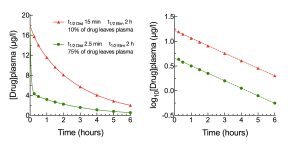One compartment drug
A one compartment drug demonstrates the observable behaviour of a drug that moves rapidly (in both directions) between blood and those tissues into which the drug distributes extensively. Because of this rapid movement, data from plasma samples that are collected at various time points after an IV injection of drug suggest that the drug is being lost from plasma as a result of a single exponential process, i.e. elimination, with a plateau at, or close to, zero drug remaining in the plasma. As a result of the rapid equilibration of drug between the plasma and those tissues into which it distributes extensively, distribution has already (almost) reached equilibrium by the time the first plasma sample is taken. As such, no graphical evidence is observed of the rapid distribution phase, and the single exponential curve, corresponding to the terminal elimination phase, appears, when extrapolated back to the concentration axis (the Y-axis) of a plot of [drug in plasma] versus time, to intersect the axis at a point corresponding to the concentration of drug present in the blood following completion of distribution, and before any drug had been lost from the body. This intercept is referred to as the concentration of drug in the plasma at t=0, or the Cp0 intercept. On the figure below, the data in green exemplify a drug behaving in this way.
Since redistribution of drug from the tissues back into the plasma is also extremely rapid for a one compartment drug, the rate at which drug is able to leave the body from the central compartment is unconstrained by any lag due to slow return of drug from the tissues back to the central compartment.
It is possible that some drug may distribute slowly into some tissues and organs. However, the portion of the total administered dose which does so is sufficiently small that it has a negligible impact on the appearance of a plot of [Drug]plasma versus time, which still resembles a single exponential decay curve. On the figure below, data for a drug behaving in this manner are shown in red.


